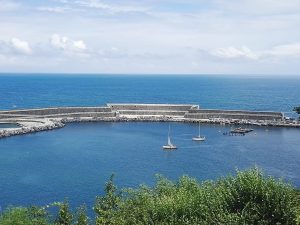Mutriku wave power plant

The town of Mutriku is located in the Basque province of Gipuzkoa, on the Spanish coast of the Bay of Biscay. Since 2011 it is home to the first commercial wave power plant in Europe. The power system consists of 16 turbines lodged inside a newly-built breakwater. It has a power rating of nearly 300 kW, which is the equivalent needed to power 100 households. The project was commissioned by the Basque Energy Board and received financial support from the 7th Framework Programme of the European Commission. The use of this plant is estimated to reduce CO2 emissions by 600 tonnes per year and its successful operation is expected to encourage similar projects around Europe and the world.
Historical background
Mutriku was founded in 1209 and its economy was always linked to the sea. The fisheries of cod and whale in Terranova fostered economic growth in the village, in the same way as it did in other coastal towns in the region. As a result, the town has a remarkable architectural heritage, with old palaces dating back to the 15th century, scattered around its narrow and steep cobblestone streets. One of the palaces was the house of Cosme Damián Churruca, admiral of the Spanish navy and scientist, who wrote astronomy books, explored navigation around the Strait of Magellan and died in the battle of Trafalgar. The house is open to the public since June 2018.
Geography and Climate
The Basque Country is a mountainous region with a complex topography. The coastline consists of cliffs, formed when the Iberian Peninsula collided with the main European continent during the Alpine orogeny. Actually, the coast between the towns of Zumaia and Mutriku is famous among geologists for its flysch i.e. layers of sedimentary rock laid out in vertical position showing over 60 million years of geological history. This stretch of coast belongs to the European Geoparks Network and can be visited by boat.
The climate of the Basque Coast is wet and mild, with mean annual precipitation ranging from 1200 mm to 2000 mm and an average temperature 14º C. It is greatly influenced by the sea: during the winter, a northwesterly airflow brings Atlantic air masses accompanied by strong winds. These air masses, ascend by effect of the mountains, condensate and generate precipitation. This is particularly true when the jet stream is in a rather southern position, around 30° – 40° N, and directs storms and fronts towards the Iberian Peninsula.
The wave power plant
The frequent storms used to cause damage to the piers and instability leading to accidents with boats. For this reason, the construction of a larger external breakwater was decided upon and began in 2006. This construction provided the opportunity to build a wave power plant, using a 100 m section of the outer wall of the breakwater. The structure is hollow and contains 16 air chambers where 16 oscillating water column (OWC) turbines were installed. This technology had been tested in Scotland since 2000. Sea water enters the chambers through a frontal opening as waves approach, compresses the air and pushes it out an opening at the top. When the waves recede, the air is decompressed and pushed out through the frontal opening. The moving air activates the turbines, so the sea water does not come into contact with the equipment, making their lifespan longer.
All the power generated is injected into the grid; the 16 turbines have a capacity of 296 kW, estimated to supply electricity for 100 households. The plant reached a milestone in the winter of 2015, when its total power generation since 2011 amounted to 1 GWh. Mutriku wave power plant can also be visited by making an appointment with the town council.
References and related links:
- https://geoparkea.eus/en/guided-tours/arrietakua-mansion?lang_code=en
- http://www.euskalmet.euskadi.eus/s07-5853x/es/contenidos/informacion/cla_clasificacion/es_7264/es_clasificacion.html
- https://geoparkea.eus/en/about-geopark/where-find-us
- https://www.power-technology.com/projects/mutriku-wave/
- http://www.eve.eus/Proyectos-energeticos/Proyectos/Energia-Marina.aspx?lang=en-GB
By Laura Zubiate, EMS Liaison Committee


Kommentare sind geschlossen.